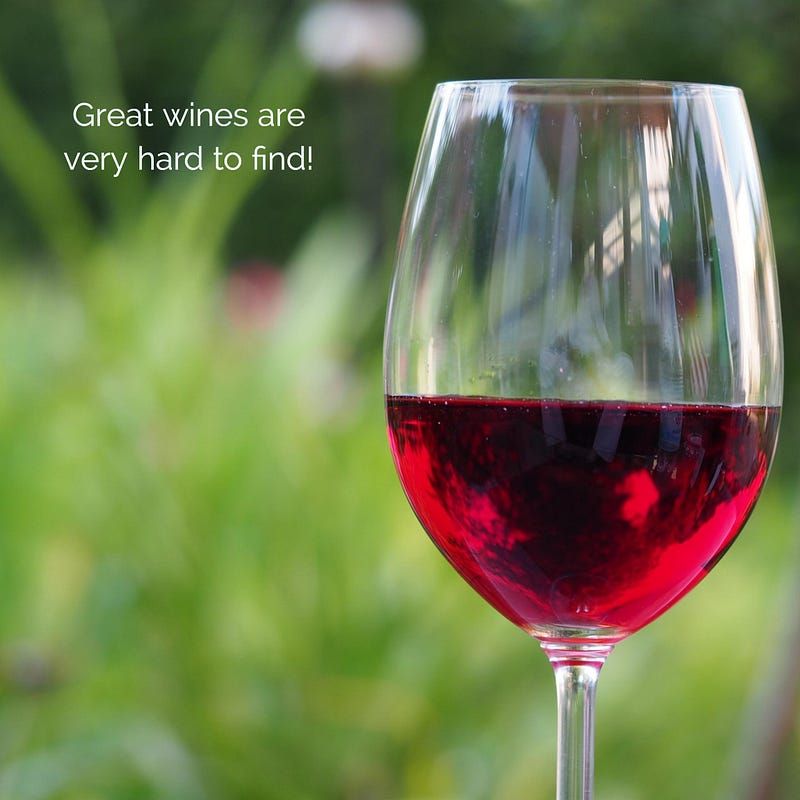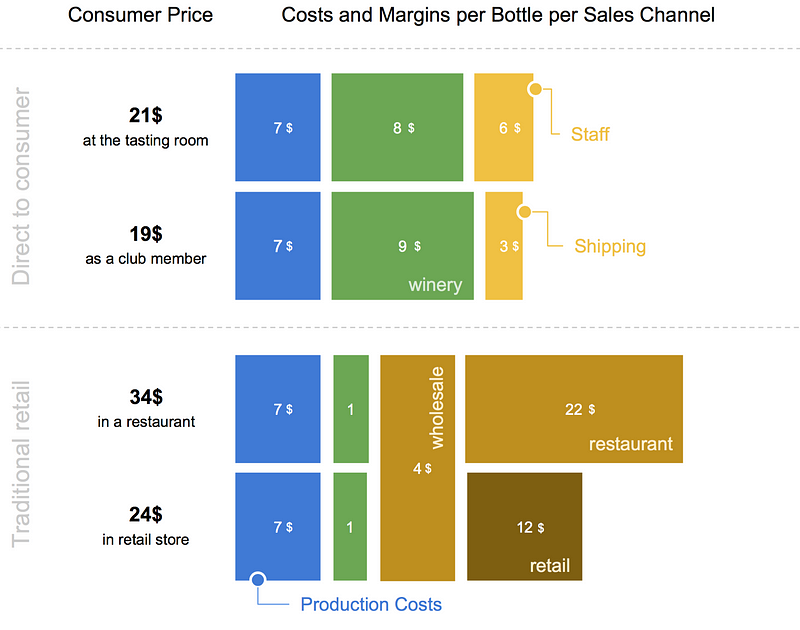Value chain in the wine Industry
Wine is a complicated industry with a large and complex value chain and many partners, such as winemakers, agents, wholesalers, distributors, retail and online merchants, logistics experts and, of course, consumers.
As we expand Subscribility and work hard to explain our vision to prospective clients and investors, we have had to pitch our business model many times and explain how money flows from the consumer to the winemaker, depending on the chosen sale channel.
Let’s consider a bottle priced at $24 in a retail bottle-shop. Of course, this example can be scaled up (higher-end bottles) or scaled-down, but, we decided to focus on this particular price segment because, in most countries, this is considered a “sweet spot” where consumers start to develop their taste for genuine wines and are ready to spend money on products they love. This is also a price that allows small wineries to generate some profits.
The four main channels for wine sales:#

Restaurants: In most countries, wine bought in a restaurant is clearly more expensive. Depending on the country, the price point can vary between twice (lucky you!) and five times the retail price.
Retail/bottle shops: Industrial wines are mainly distributed through this channel. In the retail world, our $24 bottle of wine will travel through the hands of various intermediaries such as an exporter, a wholesaler, a distributor and the bottle shop.
Cellar door/Tasting room sales: These sales happen on site, at the winery and, more often than not, during a tasting (for tourists) or some other event. This is the best possible experience for consumers because they can ask questions about the wine and meet with the winemaker or a trained staff member.
Wine Clubs: Wineries use wine clubs to create a special relationship with trusted customers. They can ship wines to their most trusted customers on a recurring basis (usually once or twice a year).
For each sales channel, we have represented the value chain and focused on the profits that will flow back to the winery.
The gory details (money!)#

Benoit. I find your foregoing diagram a little confusing. Why would the green sections be different in any of the examples? Are you confusing % with $?
Cash-flow#
There is a huge profit difference (roughly 800%) for winemakers between direct and indirect sales channels. That being said, one must also consider the risks and cash-flow impact of each channel.
- The two indirect channels, namely wholesale and restaurant sales, produce small profit margins and can negatively impact cash-flow, since it can take between 45 and 90 days for the winemaker to receive payment.
- In the two direct channel models, the winemaker is paid up front and this has a great positive impact on any business.
Business Risks:#
- The indirect sales channels are highly dependent on a few key clients. Risks are high because if, for example, a wholesaler suddenly decides to stop distributing a winery’s wines, this winery loses a huge part of its revenues and may find itself in a difficult, if not dangerous financial situation. Without a fresh injection of cash, it may have to declare bankruptcy or slash the price of its products. Most wineries are warned by their accountant that it is always risky from a business perspective to have just a few big customers that account for 30% or more of their revenues.
- The direct sales channels have a different risk profile. Hundreds of individuals constitute the client base. As such, the risk is more evenly spread and variations in volume and in sales are more stable and even predictable, based on industry data and, in the case of tasting rooms/cellar doors sales, on weather and traffic data.
Recurring revenues#
Recurring revenues are worth 5 to 10 times one-time revenues. How do these sales channels compare to each other?
- Restaurant channels are quite hard to plan for. Restaurants must adapt to changing client taste. The volume of their wine purchases is also highly dependent on the sommelier goodwill and desire to promote the winery’s brand.
- Wholesalers usually sign multi-year contracts with various options and clauses that allow for extra purchases of the same wine (at a lower cost as the volume increases). As such, these bulks purchases can be considered recurring revenues. But keep in mind that, as the part of the production sold to the wholesaler grows, the wholesaler increases his bargaining power over the winery and can ask for bigger discounts, which lowers the winery’s profit margin.
- Cellar door/tasting room sales: Sales are, most of the time, a one-time occurrence. They depend on tourism and the events happening at the winery. They have a high cost because cellar visits and tastings must be handled by a highly trained wine tasting and customer service staff. Most wineries make a determined effort to convert these one-time customers into long-term wine club members.
- Club membership: Members are people who are won over by the quality of the products and who have a great memory of their time at the winery. They quite often agree to provide their credit card information and, at least, commit to buy on a regular basis wines from the winery. Club members are very trustworthy and loyal. They are a winery’s best customers!
No wholesale for boutique and small wineries#
To complete this description of the sales channels accessible to wineries, I would like to quote the following words from Silicon Valley Bank’s Rob MacMillan:
Wholesalers don’t want small wineries. Distribution isn’t available for most wineries, so they have to elect more Direct to Consumer options. […] Most wineries will not survive without an increasing emphasis on direct-to-consumer sales.
Conclusion#
Subscribility has been designed, from the ground up, by boutique winemakers to help them set up and grow their direct to consumer sales channels. As wine-lovers ourselves, we make every possible effort to ensure that the best authentic wines are still produced and are able to reach wine-lovers’ palates, thanks to the only channel available to each winery: the Direct-to-Consumer approach.
Self-reflection:#
- What can be done to help boutique wineries reach their market?
- Why has eCommerce not yet impacted the wine industry?
Feedback is a gift 🙏: Please do not hesitate to share your thoughtsts
- via the contact page form
- via a LinkedIn connexion or message